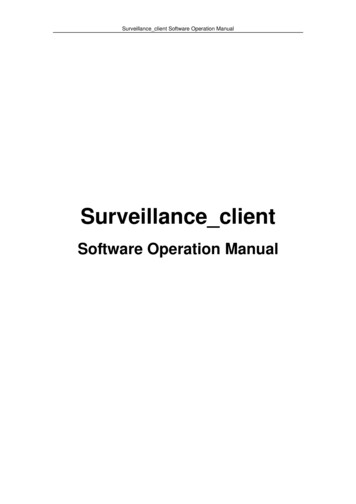
Transcription
Surveillance client Software Operation ManualSurveillance clientSoftware Operation Manual
Surveillance client Software Operation ManualContents1 Product Description . 41.1 Important Disclaimer . 41.2 Software Related Files . 41.2.1 Software Installation Directory . 41.3 Application Enviroment . 42 System Overview . 52.1 Operation Management . 53 Software Installing and Uninstalling . 53.1 Software Installing. 53.2 Software Uninstalling . 74 Description on Configuration and Operation . 84.1 Software Start-up . 84.1.1 Software Start-up. 84.2 Configuration . 84.2.1 Configuration Wizard . 84.2.2 Add Devices. 105 Preview Screen and Control Panel . 115.2 Control Panel . 145.3 Main View . 155.4 Use Multiple Windows or Monitors . 185.5 Sequence Mode . 195.6 PTZ Control . 205.6.1 PTZ Cruise . 216 Remote Playback . 226.1 Remote Playback Control . 236.2 Download Video Files . 247 Group Device Management . 257.1 Modify DVR Information . 257.2 Delete DVR . 267.3 Remote Configuration of DVR . 267.4 Create Group . 267.5 Modify Group . 277.6 Delete Group . 278 Local Log Search. 288.1 Backup Logs . 299 Account Management . 299.1 Enable Password of Admin Account . 309.2 Add User Account . 309.3 Modify User Account . 319.4 Delete User . 3210 File Management. 32-2-
Surveillance client Software Operation Manual11 Video Player . 3311.1 Play downloaded files/Cut videos/Local video files . 3311.2 Video Play Control . 3412 System Configuration . 3412.1 General . 3512.2 File . 3512.3 Alarm Sound . 36-3-
Surveillance client Software Operation Manual1 Product Description1.1 Important DisclaimerThank you for using Surveillance client series products. Please carefully read thesoftware operation manual before operation.As the software may be updated at any time, the contents of the operation manual aresubject to change without prior notice.Disclaimer:The company has sought to the integrity and accuracy of the contents of the operationmanual during the compilation process and will not be held liable for any errors oromissions. The company reserves the right to change the software mentioned in theoperation manual at any time without prior notice. Thank you for choosing our products.Please carefully read this manual before operation. We assume no economic and legalresponsibility for the losses caused by the operation not according to the stipulations.1.2 Software Related FilesThe files for software installing, running, recording and sharpshooting are in the followingfolders by specific paths.1.2.1 Software Installation DirectoryThe default software installation path: C:\Program Files\ATV\Surveillance client.User can define the path for installation.1.3 Application EnvironmentRequirements for system configuration:HardwareCPU:Intel Core 2 Duo 2.4GHZ or HigherRAM:2GB or higherVGA:DirectX 9.0 compatible VGA card, NVIDIA GeForce 9500GT or higher, with videomemory of 512MB or larger(Make sure the graphics driver provided by the computer supplier has beeninstalled.)Network Card: Recommend to use gigabit NIC, (including network card, router, switch andnetwork cables of 5e or higher specifications for RJ45 port)Disk Space: At least 1GB space should be available except the required space forrecording.OS: Window Vista Business, Enterprise, Ultimate(32 bit or 64 bit)Window 7 Professional, Enterprise, Ultimate(32 bit or 64 bit)Window 8, Window 8 professional, DirectX 9.1 or higherMac OS: 10.6 or higher-4-
Surveillance client Software Operation Manual2 System Overview2.1 Operation ManagementIn consideration of the functions and features of the software, we strongly recommendthat:zAll the operators should be trained so as to avoid forming the artificial weak point ofprotection system.zSound user management mechanism and level should be established and the lowlevel user’s access should be restricted so as to avoid the possibility of the incorrectoperation.3 Software Installing and Uninstalling3.1 Software InstallingDouble click the installation file “ATV Sky Remote” to install the software.1 The following window will be popped up.Fig.3-12.Click NextFig.3-2-5-
Surveillance client Software Operation k:\ProgramFiles\ATV\Surveillance client. To change the installation path, please click Browse tocustomize. (Fig. 3-2)Confirm the installation path and then click Next.Fig. 3-34. The program’s shortcut will be created in the following Start Menu folder. The defaultinstallation path is ATV\Surveillance client. If you want to select a different folder, pleaseclick Browse to customize. (Fig. 3-3)Confirm the installation path and then click Next.Fig. 3-45. Select the additional tasks you would like Setup to perform while installingSurveillance client. Additional icons: 1. Create a desktop icon, 2. Create a Quick Launchicon. (Fig.3-4)。6. Click Install to start installation. (Fig. 3-5)-6-
Surveillance client Software Operation ManualFig. 3-5Fig. 3-55. After software setup finished, the following window will be popped up. Click Finish toexit Setup. (Fig. 3-6)Fig. 3-63.2 Software UninstallingUser can uninstall the software in Add and Remove Programs of the Control Panel.User can also run the Uninstall program by the following steps:1.Click Start button ÆAll programsÆATV\Surveillance clientÆUninstallSurveillance client, the following window will be popped up. Click Yes.-7-
Surveillance client Software Operation ManualFig. 3-72.System starts uninstalling the software and the process will be automatically finished.4 Description on Configuration and OperationIn this chapter, we’ll learn the specific operation of Surveillance client.4.1 Software Start-up4.1.1 Software Start-upAfter installation is finished, a shortcut for Surveillance client will be generated on thedesktop. Run the program by double clicking the shortcut Surveillance client on thedesktop or click Start ÆAll ProgramsÆ ATV\Surveillance client Æ Surveillance client.Run the software for the first timePlease start the program Surveillance client.1. Click Login. No password by default.Click LoginFig. 4-14.2 Configuration4.2.1 Configuration Wizard1. Run Surveillance client and Add Device Wizard will be opened. Click Next.-8-
Surveillance client Software Operation ManualFig. 4-2Note: If Add Device Wizard is not opened, please single click Help to manually open it.2. Click Add Online Device and the client software will scan all the online network DVRsin LAN.Display online devicesFig. 4-33. Click a DVR in the list and the added devices, IP address, port and channel number willbe displayed. Click Add Selected Device to add.Click a DVR in the list.Fig. 4-4Note:If your DVR is not available in the list, click Exit and then click add to manually inputthe IP address of DVR.-9-
Surveillance client Software Operation Manual4.Input the name of the selected DVR in Device Name field, e.g. home, office, etc.5.Input user name in User Name field (default name is admin)6.Input password in Password field. The password field is blank by default. You maychange the login password of DVR.4.2.2 Add Devices1. Click Add.Input the name of your DVRInput user name (admin bydefault)Input password if the passwordverification is activated.Click AddFig. 4-52.Click Import All to import all DVRs to the default group.Click Import AllFig. 4-6- 10 -
Surveillance client Software Operation Manual9.Click Next and then click Finish to complete the wizard.5 Preview Screen and Control Panel1. Click Main ViewFig.5-12. Click and drag it to the default group in the show grid.Fig. 5-2- 11 -
Surveillance client Software Operation Manual5.1 Add DVR by Using DNSIf DVRs use dynamic domain names, you may add them into Surveillance client。Preconditions:z Create a DDNS account.z Enter domain information and enter DVR local.z Map the port to the router.Add a DVR by using DDNS:1. Select ‘Control Panel’ option and click the Group Device Management.Click Group DeviceManagementFig. 5-32. Click Add Device.3. Configuration:Input the name of your DVRInput IP adressInput the port of the client (Defaultvalue: 9000)Input user name (admin by default)Input password (default: blank)Click Add- 12 -
Surveillance client Software Operation ManualFig. 5-4zDevice Name: Input the name of your DVR, e.g. home, office, etc.zIP Address: Input domain name, for example, 3322.org.zPort:Input the client port of DVR (Default: 9000).zUser Name: Input user name (admin by default).zPassword:Input password. The password field is blank by default unless thepassword verification has been activated for DVR.4. Click Add.5.Click import all to import all DVRs to the default group.6.Click ‘Control Panel’ option.7.Click Main View.Click Main View.Fig. 5-58.Click and drag it to the default group in the displayed window.- 13 -
Surveillance client Software Operation ManualFig. 5-6ResultFig. 5-75.2 Control PanelYou may access to your DVR through control panel to preview and playback the videos.You can also open control panel and click the control panel option at any time.Fig. 5-8- 14 -
Surveillance client Software Operation ManualThe following options can be found in the Control Panel:z Main View: Remotely preview the videos. Refer to 5.3 Main View for details.z Remote Playback: Play the recorded videos in the DVR. Refer 6. Remote Playback fordetails.z Group Device Management: Manage DVRs and camera groups. Remotely controlthe DVR configuration. Refer to Group Device Management for details.z Local Log Search: Search log of DVR. Refer to Local Log Search for details.z Account Management: Set up the account and password for the client software. Referto Account Management for details.z File Management: View and management the snapshots and recorded files. Refer toFile Management for details.z System Configuration: Configure Surveillance client. Refer to System Managementfor details.5.3 Main ViewUser may preview the videos in Main View. To access to Main View, enterControl Panel and click Main View ()⑩①⑨②③ ④⑤⑥Fig. 5-9- 15 -⑦⑧
Surveillance client Software Operation Manual1.DVR List: Display all DVRs and camera groups connecting to the client software.zCamera group is indicated by the iconzIcons related to DVR:and DVR is indicated by the icon。Camera is onlinePreview the camera videoCamera is offline(connection problem)zClick and drag the camera, camera group or show grid to open.Tip: You may click and drag the camera and create customized view from differentDVRs.2.Hide the list of DVR/Camera: Click the arrow to hide/display DVR list.3. Alarms: Click alarm panel and the system alarm list and events, e.g. motion detectionevent, will be displayed on the screen.Fig. 5-10:Click to remove all the alarms in the list.4. Remove alarms:Click to enable mute or cancel mute. Set the alarming5. Mute alarming soundsound.6. Toolbar of the Main View:zFull screen displayexit.zSelecting a layoutzStop status displayzScreenshotzCut videoszPrevious/Next:Click to enable full screen display and press ESC to:Split screen mode selection key:Click to stop all channel previews.:Click to save the screenshot of the current channel.:Click to start/stop cutting currently selected channel video.:Click to go to previous page or next page.- 16 -
Surveillance client Software Operation ManualzSequencezAudio:Click to configure sequence mode.:Audio ON/OFF7. Page:When multiple cameras are opened, the screen is split to formmulti-screen display window and many pages are formed. The number of currentpage and total page is displayed on the bottom of the screen.8. Alarm Control Panel:zAuto-hide:Click to enable/disable the auto-hide function of alarm panel.zMaximize the alarm panel: Maximize the alarm panel in the tab page.zDisplay/hide alarm panel.9. Camera Display:Select a channel and put the cursor on the toolbar of the channel.The toolbar contains the following options:Click a channel toopen toolbar.Fig. 5-11z Cut videosz Screenshotz PTZ:Click to start or stop cutting the currently selected channel video.:Click to save the screenshot of the current channel.:Click to use PTZ control. Refer to PTZ Control for details.z Stop Video:Click to stop the current channel video.z Digital Zoom:Click to use digital zoom mode.z Color setting:Open the color setting menu of the current camera.z Mute:Mute/unmute the current preview video.10.CPU status:Display CPU utilization.- 17 -
Surveillance client Software Operation Manual5.4 Use Multiple Windows or MonitorsCreate multiple tab pages of preview video windows. Customize the preview videowindows as required (4 tab pages can be opened at most).Open multiple windows:Click preview tab page and drag it out of the main window to create the 2nd displaywindow.Click and drag itout of the mainwindow.Fig. 5-11Result:Open multipletab pages. Youcan monitordifferent videosfrom multiplemonitors.Fig. 5-12- 18 -
Surveillance client Software Operation Manual5.5 Sequence ModeWhen Sequence Mode is enabled, the main view will be in automatic cycle mode insetting time. You may set sequence mode for one or all preview video window.Use Sequence Mode:1. Clickto enable sequence mode control.2. If you want to use Sequence Mode in current window, click Current Main View andselect ‘Independent’ or ‘Sync With Global’ to perform independent sequence forcurrent window or synchronize with other windows in the same time interval.Click ‘Current Main View’to use Sequence Mode forcurrent window.Fig. 5-13orIf you want to use Sequence Mode in all windows, click ‘Global Main View’. All main viewwindows which are selected ‘sync with global’ will be in synchronized sequence mode. If‘Force all main view synchronize with global’ is selected, all main view windows will beforced to sequence in the same time interval.Click ‘Global Main View’ touse Sequence Mode in allwindows- 19 -
Surveillance client Software Operation ManualFig. 5-143.Use slider to set the Switch Interval (dwell time)。4.Click to start sequence mode.5.6 PTZ ControlIf you have a PTZ camera, you may perform remote control by using software.Note: Before remote control of PTZ, please make sure the relevant parameters of PTZhve been set in DVR. Refer to operation manual of DVR for the detailed setting of PTZ.PTZ Camera Control:1. In Main View, put cursor on PTZ camera and the toolbar will appear. ClickPTZ control.Open PTZ controlFig. 5-15PTZ ControlUse cursor to controlAdjust the zoomthe position of cameraAdjust the focusAdjust the apertureAdjust PTZ speedStart/Stop PTZ CruiseConfigure/Call preset pointFig. 5-16- 20 -to open
Surveillance client Software Operation ManualSet PTZ positionCall preset pointClick to set Preset pointSet preset pointDelete preset pointSelect preset numberFig. 5-175.6.1 PTZ CruiseWhen PTZ cruise is enabled, PTZ will start cruising through saved preset point. Set morethan two preset points and cruising can be started.Start/Stop PTZ cruise.1.Click Cruise.2.Clickto start PTZ cruise and clickto stop PTZ cruise.Click to enable cruise controlClick to stop cruisingClick to start cruisingFig. 5-18- 21 -
Surveillance client Software Operation Manual6 Remote PlaybackUser can view the audios and videos recorded by DVR in the computer through remoteplayback.Remote Playback:1.Click remote controlon the control panel.2.Select the video channel for remote playback.3.Playback can be done in 4 channels at the same time.4.Select playback in calendar. The red triangle icon indicates that there is video availablefor playback.5.Click Search to show the current videos of DVR.6.Clickto play the selected event.7.Click to select play time in time fence.Select a camera to playSelect a date in calendarClick Start to playClick the time fence to selectplay time.- 22 -
Surveillance client Software Operation Manual6.1 Remote Playback ControlSelect DVR/Camera GroupSelect Camera PlaybackSelect File TypeEnable Synchronous PlaybackSelect Playing DateSearch VideoPrevious periodMove tothe rightClick to select playing timeAmplify timeDownloadStep ForwardFast ForwardFast BackwardStopPausePlayZoom in/outScreenshotMuteCut videoMuteFour split screenOne split screenFull ScreenFast For wardFast BackwardStopPausePlay- 23 -
Surveillance client Software Operation Manual6.2 Download Video FilesDVR video files can be remotely downloaded.Download video files:1. Put cursor on the video and clickto open download menu.Click to open the download menu.2. Select a file and click Download. Wait seconds and the download will be started.Video FilesClick to download- 24 -
Surveillance client Software Operation ManualVideo file format is .264. Video player is internally installed in Surveillance client. If youwant to convert .264 to AVI, please use AVIGenerator on the attached CD.7 Group Device ManagementGroup Device Management Menu is used for managing DVR and camera group.The device panel on the left allows you to add, modify and delete DVR system andremotely control DVR device. You can set up camera group by the group panel on theright. Import the channels from device panel into group panel to access the videos orplayback. You can select different channels from multiple devices to a group. Thedefaultgroup is created by default. You may create new group as required.Add groupModify groupDelete groupCamera groupDVRManually add DVRDVRCameraScan DVR in LANCamera7.1 Modify DVR InformationUser can modify the name of DVR and delete DVR or camera from group.Modify DVR information:1.In the device list, left click DVR to be modified and then click- 25 -.
Surveillance client Software Operation ManualClick to select DVR2.Modify DVR information and save.7.2 Delete DVRYou may delete DVR from Surveillance client.Delete DVR:Click to select DVR to be deleted and then clickand save to delete DVR.Click DVR to be deleted7.3 Remote Configuration of DVRYou may remotely configure DVR parameters by software.Remotely configure DVR:zClickto set parameters. Refer operation manual for details.Click to configure theparameters of DVR.7.4 Create Group1. Click Add. Input a customized name and then click Yes to confirm.Click Add- 26 -
Surveillance client Software Operation Manual2. Import DVR channel to group. Select DVR or camera to be imported in the left list toimport them to the selected group.Import the selectedcameraImport all channels ofDVR into group.7.5 Modify GroupModify group name/Delete DVR or camera from group.1. Click group name and then click Modify. Input name to be modified in the pop-up boxand save by clicking Yes.Click ModifyClick Group2. Click the name of DVR/camera and click Modify. Input the name to modified in thepop-up box and save by clicking Yes.Click ModifyClick camera or DVR7.6 Delete GroupDelete the name of Group/DVR/Camera1.Click Group/DVR/Camera.2.Click Delete and then click Yes to confirm.- 27 -
Surveillance client Software Operation ManualClick DeleteClick camera groupzClick camera group and click Delete. Click Yes to confirm.8. Local Log Search‘Local Log Search’ refers to searching the log of Surveillance client. Defaultly it cansearch one week’s log. User may define the log reservation time as one month. Refer tosystem setting for details.Search log:1.Click Local Log Searchon the Control Panel.2.Set the following search options:zUser Name:Select ‘All Users’ to search logs created by all users, or select ‘SpecificUser’ to view his log.zLog Type:Alarm log records motion detection alarms and system alarms. Operationlog records configuration change or access of system users to log system (such aslogin and logout)zAll Type: Select to search logs of all type or specific type.zGroup:Select DVR or Camera group to search desired logs or select All Groups tosearch logs of all DVRs and camera groups.zStart Time/End Time: Select start time or end time of searching.3.Click Search and all logs meeting search conditions will be displayed in the list.Set searchingparametersClick Search- 28 -
Surveillance client Software Operation Manual8.1 Backup LogsUser can back up the log search result in the hard disk or view backup log.Backup log:1.Search log by following above steps.2.Click BackupClick Backup3.Select a folder and input a file name and then click Save.Open saved log file:1. Click to view backup.Click to viewBackup and opensaved log files.1. Select log file and click Open.9 Account ManagementUser may use Account Management menu to create Surveillance client user account.The client software includes the following user types:zAdmin:When you firstly run the client software, the default account is admin. Theadministrator has the privilege to operate client software and remotely configure DVRparameters. The administrator can add, modify or delete any other user accounts.- 29 -
Surveillance client Software Operation ManualzUser:It is standard user account. User’s privileges are assigned by administrator.User cannot change software setting or change other user account. User can changehis own password.Visit Account Management: Click Account Managementon the Control Panel.9.1 Enable Password of Admin AccountThe password for admin account is blank by default. No password input is needed to login Surveillance client. If password is set for admin account, operator has to inputpassword to log in the client.Create password for admin account.1. To login with admin account, please click admin account and then click Modify.Click ModifyClick User Name2.Input password for admin account and repeat inputting to confirm.3.Click Save to save password.Note : Clickto lock Surveillance client and user should input password foradministrator. Or the user can click System Change user to user other user account tologin. Please note that admin account does not logout until another account login.9.2 Add User AccountNote:Only administrator is allowed to create new user account.1.Click AddClick Add- 30 -
Surveillance client Software Operation Manual2.Configuration:zInput password for user account and repeat inputting to confirm.zSelect privileges for the user account on the bottom area.Set User Type and PasswordSelect user Privilege3.Click Save to create user account.9.3 Modify User Account1. Click the account to be modified and click Modify.Click ModifyClick user2.Edit the settings and privileges of common users and click Save.Note:Common users can only modify his own password while administrator canmodify the password or privileges of any user.- 31 -
Surveillance client Software Operation Manual9.4 Delete UserzClick user you want to delete and click Delete and click Yes to confirm.Click DeleteClick userNote: Only administrator can delete common user.10 File ManagementUse file management to view local videos and screenshots.Use file management:1.Click file managementon the Control Panel.2.Select the camera or DVR you want to search on the left of the screen.3.Click Video to search manual videos or click Picture to search screenshot.4.Set start time and end time. Time period for cutting videos and pictures is for recordingoriginal videos, not for saving files.5.Click to search files.6.Double click to open files or use button on the bottom of the screen to delete or savefiles in your computer.- 32 -
Surveillance client Software Operation ManualSelect Picture or VideoSet Start Time and End TimeSelectcameraSearch filegroup, DVRor camera.Delete fileClick to save file in a different location.11 Video PlayerVideo player can play downloaded files/ cut videos/ local video files.11.1 Play downloaded files/Cut videos/Local video files1.Click File Open Video File. The video player will be opened.Click File Open Video File2.Clickand select the video file and click Open to play the video file.- 33 -
Surveillance client Software Operation ManualClick to open a video file.11.2 Video Play ControlCloseMute On/OffPlayStopPlay by frameFast ForwardPausezZoom in: clickScreenshotZoom in/outFast Backwardand then click and drag on the picture, and click again to zoomin.12 System ConfigurationSystem configuration is used for configuring Surveillance client.- 34 -
Surveillance client Software Operation ManualSystem configuration:zClick system configurationon the Control Panel.12.1 GeneralConfigure general settings:1.Configuration:zLanguage: Select a language.zLog Keeping Time: One week/Half month/One month.zEnable audio on multiple channels simultaneously: Enable multi-channel audio outputand play multi-channel audio.zEnable auto-login: Automatically login without inputting account and password.zResume Live View Status: Open software and the last live view status will beautomatically resumed.2. Click Save to save the modification.12.2 File- 35 -
Surveillance client Software Operation ManualSet saving path of files (Video files and image files)You can set an alarm message. When the disk space for saving files is less than the setspace, the alarm message will appear. The default setting is 600MB.Configure the folder for saving files:1.Click and select the required folder.2.Click Save to save the changes.Set alarm for insufficient disk space:Alarm will appear if disk space is sufficient. When the disk space for saving is lessthan set space, the alarm will appear. The minimum value is 500MB.12.3 Alarm SoundCustomize alarm sound: Allow you to configure alarm sound. You may use any WAV fileto be the alarm sound.Play audio alarmClick to select aaudio for alarm(wav file)Save- 36 -
Surveillance client Software Operation ManualAll rights reserved. No reproduction is allowed.1. No person should copy, distribute, re-record or store any contents in the productrelated manual in the retrieval system or translate the contents into o
Surveillance_client Software Operation Manual - 4 - 1 Product Description 1.1 Important Disclaimer Thank you for using Surveillance_client series products. Please carefully read the software operation manual before operation. As the software may be updated at any time, the contents of the operation manual are subject to change without prior notice.




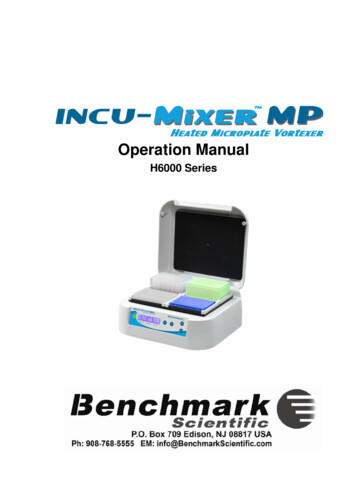
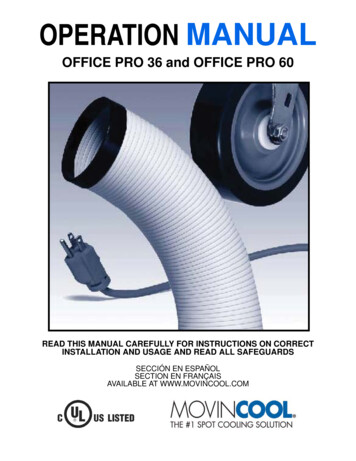
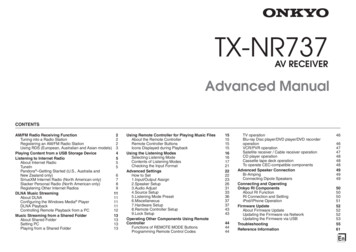
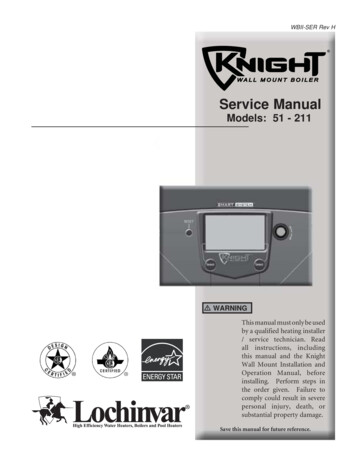
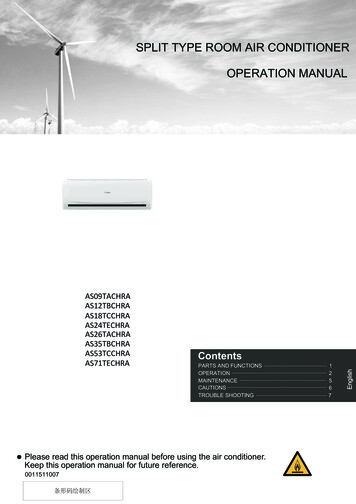
![[meat] OP12 Operation - SupplyHouse](/img/53/movincool-op24-operatormanual.jpg)
